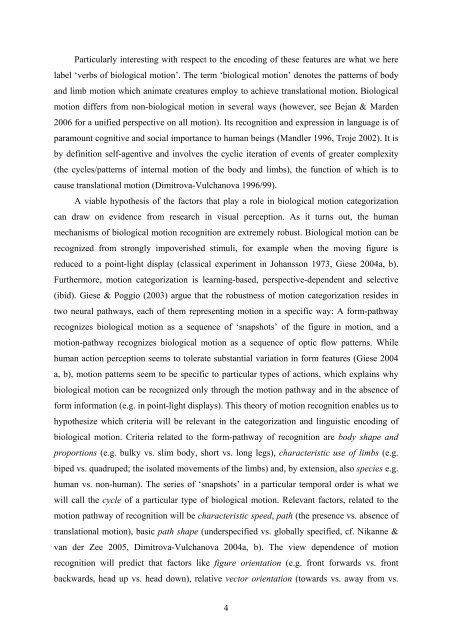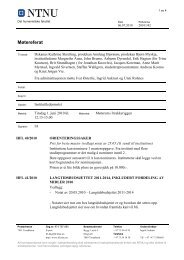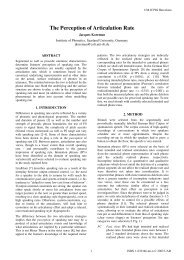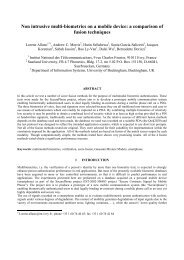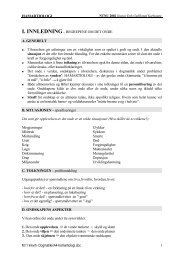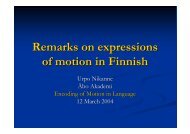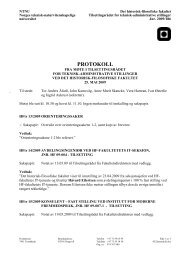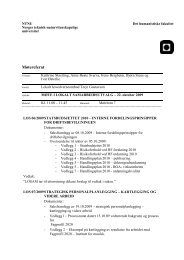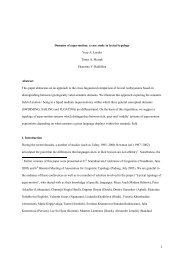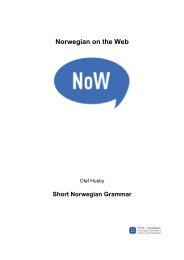In press: In: Dimitrova-Vulchanova, M - NTNU
In press: In: Dimitrova-Vulchanova, M - NTNU
In press: In: Dimitrova-Vulchanova, M - NTNU
You also want an ePaper? Increase the reach of your titles
YUMPU automatically turns print PDFs into web optimized ePapers that Google loves.
Particularly interesting with respect to the encoding of these features are what we here<br />
label ‘verbs of biological motion’. The term ‘biological motion’ denotes the patterns of body<br />
and limb motion which animate creatures employ to achieve translational motion. Biological<br />
motion differs from non-biological motion in several ways (however, see Bejan & Marden<br />
2006 for a unified perspective on all motion). Its recognition and ex<strong>press</strong>ion in language is of<br />
paramount cognitive and social importance to human beings (Mandler 1996, Troje 2002). It is<br />
by definition self-agentive and involves the cyclic iteration of events of greater complexity<br />
(the cycles/patterns of internal motion of the body and limbs), the function of which is to<br />
cause translational motion (<strong>Dimitrova</strong>-<strong>Vulchanova</strong> 1996/99).<br />
A viable hypothesis of the factors that play a role in biological motion categorization<br />
can draw on evidence from research in visual perception. As it turns out, the human<br />
mechanisms of biological motion recognition are extremely robust. Biological motion can be<br />
recognized from strongly impoverished stimuli, for example when the moving figure is<br />
reduced to a point-light display (classical experiment in Johansson 1973, Giese 2004a, b).<br />
Furthermore, motion categorization is learning-based, perspective-dependent and selective<br />
(ibid). Giese & Poggio (2003) argue that the robustness of motion categorization resides in<br />
two neural pathways, each of them representing motion in a specific way: A form-pathway<br />
recognizes biological motion as a sequence of ‘snapshots’ of the figure in motion, and a<br />
motion-pathway recognizes biological motion as a sequence of optic flow patterns. While<br />
human action perception seems to tolerate substantial variation in form features (Giese 2004<br />
a, b), motion patterns seem to be specific to particular types of actions, which explains why<br />
biological motion can be recognized only through the motion pathway and in the absence of<br />
form information (e.g. in point-light displays). This theory of motion recognition enables us to<br />
hypothesize which criteria will be relevant in the categorization and linguistic encoding of<br />
biological motion. Criteria related to the form-pathway of recognition are body shape and<br />
proportions (e.g. bulky vs. slim body, short vs. long legs), characteristic use of limbs (e.g.<br />
biped vs. quadruped; the isolated movements of the limbs) and, by extension, also species e.g.<br />
human vs. non-human). The series of ‘snapshots’ in a particular temporal order is what we<br />
will call the cycle of a particular type of biological motion. Relevant factors, related to the<br />
motion pathway of recognition will be characteristic speed, path (the presence vs. absence of<br />
translational motion), basic path shape (underspecified vs. globally specified, cf. Nikanne &<br />
van der Zee 2005, <strong>Dimitrova</strong>-<strong>Vulchanova</strong> 2004a, b). The view dependence of motion<br />
recognition will predict that factors like figure orientation (e.g. front forwards vs. front<br />
backwards, head up vs. head down), relative vector orientation (towards vs. away from vs.<br />
4


